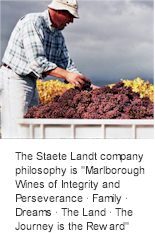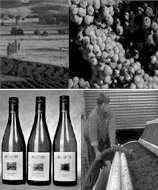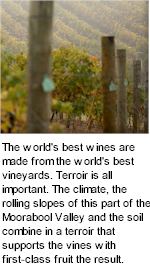| |
|
|

|
It was Charles William Ferguson who established Houghton as a national brand and lead the way for Jack Mann to advance West Australian viticulture into a leading global winegrowing region
The Most Exquisite Parcels Of Frankland River Cabernet Sauvignon Are Vinified In Traditional Open Top Fermenters And Filled To A High Proportion Of New Bordeaux Coopered French Oak Barriques For Sixteen Months The inclusion of a large component Malbec makes CW Ferguson a sensationally well rounded Cabernet style wrapped in a muslin of seamless, velvet tannins.
|
|
|
|

|
|
|

|
Spencer Hill make wine because they enjoy the life
The Viticulture And The Art Of Winemaking Itself There is no reward like personal fulfillment and Spencer Hill are all about sharing the smile The limited release Latitude 41 is fashioned from a collation of Nelson River and Marlborough Valley fruit. By combining the best from both districts, the Spencer Hill team have assembled a South Island Sauvignon Blanc of exquisite charm and generous palate weight. A crisp, mouthfilling wine brimming with luscious south sea fruit characters, citrus and vanilla.
|
|

SHIRAZ VINES WERE ESTABLISHED AT BALGOWNIE ESTATE IN 1969, followed by a second planting in 1974. The carefully selected site near Bendigo has provided excellent conditions throughout four decades, producing impressive reds since the inaugural vintage of 1972. Balgownie is most notable for its deep red colour, vibrant berry fruit aromas, subtle use of oak, velvety textures and fine, lingering tannins. A splendid match to crackling encrusted, succulently roast joint of juicy young pork.

GEWURZTRAMINER GROWS BEAUTIFULLY ALONG THE ROLLING HILLSIDES OF CLARE VALLEY. It is here that choice clones of Traminer have taken very well to the soils and climes that are so similar to growing conditions in Alsace, whence this piquantly flavoured varietal originates. Fashioned to express the bold flavours and vibrant aromas of fully ripe Gewurztraminer, while reflecting the pastoral charm and fragrant grace of the picturesque, undulating landscapes in Valley Clare.

PIGEOULET IS THE VINEYARD DELINEATION WHERE THE ILLUSTRIOUS VIEUX TELEGRAPHE OF CHATEAUNEUF-DU-PAPE MAINTAIN THEIR OFFICES AND MANAGE THE ESTATE CELLARS. Le Pigeoulet acquired its own unique nomenclature in 1998, when the terroir of Caromb was incorporated into the Cotes du Rhône appellation. A further plot to the south of the village at Châteauneuf-du-Pape, on the east bank of the Rhône, is planted mainly to forty year old Grenache, Syrah and Cinsault vines, and amounts to a third of the source for the complex cépage of Le Pigeoulet.

YALUMBA HAVE DRAWN CABERNET SAUVIGNON AND SHIRAZ FROM SOME OF THEIR BEST BAROSSA VINEYARDS. The Scribbler emulates one of Australia's most revered wines Signature Cabernet Shiraz, which has been released continuously to devotees since the inaugural 1962 vintage. Scribbler is a new and recent classic, thanks to Yalumba's long established tenure as custodian of the Barossa's finest vineyards. Equal parts Cabernet and Shiraz, the revered and enduring Claret style in Australian red wine.
|
Staete Landt make
true single vineyard handcrafted wines produced from grapes grown on the family estate on Rapaura Road in Marlborough
Staete Landt is the old Dutch name that Abel Tasman gave to New Zealand when he discovered the land in 1642 and means 'Land discovered in honour of the Governors of the Dutch Republic'. On his voyage Abel Tasman also discovered Tasmania -Van Diemen Land, Fiji and Tonga. At his return to the Dutch Republic it was decided to change Staete Landt to its present name New Zealand.

Tremendous efforts are undertaken in the vineyard to get balanced vines delivering consistently ripe healthy fruit with concentrated Marlborough flavours. In the winery these flavours are nurtured by using traditional winemaking methods combined with the latest winemaking technology.
The Staete Landt Vineyard is designed to produce single vineyard, hand made wines with complexity through thorough use of clone, rootstock and soil variation. The winemakers carefully designed the vineyard around the styles of wines they planned to produce, not the reverse. Major focus is on the vineyard where healthy, balanced vines, will in turn deliver consistently ripe fruit with distinct Marlborough flavours.
Through vine thinning and manual leaf plucks the focus is on low yields to grow intensely flavoured grape berries
The Marlborough Environmental Award 1999 was awarded to Staete Landt Vineyard for the successful implementation of an intricate irrigation design taking into consideration soil characteristics, grape varietals and scarce water resources. From an environmental perspective the implementation of the vineyard design proved to be an example for other future vineyard developments.
The vineyard's close proximity to the Wairau river, the main river in the Marlborough valley, produces a continuous airflow which keeps frosts away at crucial times during the grape growing season from budburst September/October through to harvest March/April. The combination of the location of the vineyard, the stony riverbed soils and the heavier soils on the southern part of the vineyard allow production of single vineyard wines with depth and different layers of flavours.
Four main varietals, Sauvignon Blanc, Pinot Noir, Chardonnay and Pinot Gris were carefully mapped across these soiltypes in parcels which would give every varietal presence on both dominant soil types. By varying rootstocks and varietal clones a further focus was brought to bare on the distinct terroir. The vineyard is divided into 18 parcels.
Delatite Winery is
a medium sized family-run operation that was established in 1982 by Robert and Vivienne Ritchie
Specialising in cool climate wines, especially the aromatics, it is sited on a picturesque rise overlooking the vineyards toward Mt Buller in North-east Victoria. As custodians of the land since the late nineteenth century, the Ritchie family is committed to sustainable agricultural practices and winemaking with integrity. Visit the Delatite cellar door if you are ever in the district, and sample the award-winning wines.

Delatite Winery began in the late nineteenth century, when Geoffrey Ritchie left the western part of Victoria to look for greener pastures. He intended traveling to Queensland, but fell in love with the fertile valley of Mansfield in the shadow of the snow-capped mountains, and settled on the banks of the Delatite River.
It was Geoffrey's grandson Robert who with his wife Vivienne first planted vines in 1968. The story goes that Robert was having a drink and a chat with a wine maker from Hardy's at nearby Mt Buller one evening, and a week later 3000 cuttings arrived on the door, somewhat to his astonishment. They planted them on the steep ironstone based slopes surrounding their house and added their care to the rest of the farm work. Ten years, and several hectares, later they were joined in the business by their daughter Ros, one of the first female winemaking graduates of Roseworthy College in South Australia, and the winery was built.
The effect Delatite had on the new breed of wineries was immediate. The first vintage won gold at the shows and they quickly rose to become an Australian benchmark for cool-climate white wines, especially in Riesling and Gewurztraminer. Not long after, their second son David came on board to help his father in the vineyard and his mother with the selling.
But it wasn't all plain sailing, by a long shot. Sticking to their belief that the wines should be showpieces for their new winegrowing area has often meant tough times, great sacrifices and relentless hard work.
Twenty years later and their efforts have paid off. Their successful and productive winery has a reputation both here and abroad for producing some of the finest aromatic whites in Australia, elegant Bordeaux style reds and their critically acclaimed Demelza sparkling wine. In keeping with the family's commitment to the land and their environment, they have recently introduced biodynamic practices in the vineyard. It is still wholly family owned and now Ros and David look forward to generations of successful winemaking.
Its relative youthfulness
not withstanding, the New Zealand based Villa Maria Group is establishing a reputation as one of the great wine companies of the world
Founded in 1961 and still operated by George Fistonich, Villa Maria has been New Zealand's leading wine award winner, both nationally and internationally since the early 1980's. Villa Maria's talented people have an unrelenting passion to produce quality wines.

Realising that it takes more than just good winemaking to produce quality, a passion to succeed begins in the vineyard. Astute site selection by Villa Maria's vineyard experts, is followed by superior vineyard management and then complemented by expert winemaking. A strong focus on continually improving the vineyards is considered by Villa Maria to be an incredibly important factor in quality winemaking.
Vineyards have the highest of priority for Villa Maria whose team really does live and breathe the philosophy that it all starts in the vineyard. The grapes produced must be superb quality, as this is the essence of good winemaking. Villa Maria owns vineyards and sources grapes from contract growers from some of the best sites in three of New Zealand's leading grape growing regions; Marlborough, Hawke's Bay and Gisborne.
Villa Maria Estate has two state-of-art wineries in New Zealand. The largest is the new Auckland Winery and Vineyard Park. The Marlborough winery is based in one of New Zealand's premium grape-growing regions. The winery now crushes Villa Maria's Marlborough harvest from its vineyards and contract growers throughout the region. A new winery in Auckland was essential for Villa Maria to meet the increased domestic and export demand for wines and it has been designed to allow for long-term growth. Villa Maria also has 20 hectares of vines at the Auckland Winery site.
As well as managing the company and publicly owned vineyard sites, Villa Maria's winemaking team work closely with contract growers. Villa Maria has a team of 80 dedicated contract growers in Hawke's Bay, Gisborne and Marlborough who grow grapes under the close guidance of the company’s vineyard experts. Villa Maria's viticulturists, based in all three regions, have one focus - to consistently deliver quality fruit that is physiologically ready, to the winemakers.
Villa Maria was named as one of the world's 50 great wine producers by Wine Spectator. Named New Zealand Wine Company of the Year at Australia's Winestate Wine Awards for the sixth time in seven years. New Zealand Wine Producer of the Year and Best Sauvignon Blanc Trophy - 2004 International Wine and Spirit Competitions in the United Kingdom. Trophy for the Most Successful Exhibitor at the 2004 New Zealand Wine Society Royal Easter Show for the third time in four years and winemaker Alastair Maling MW, collecting the Gold Medal for Champion Winemaker of the Show. This is the third time in four years Villa Maria winemakers have won the award. George Fistonich was also short listed as one of 50 prominent figures in the wine industry by UK Wine International Magazine, named New Zealander of the year by the prestigious National Business Review, and in the top ten New Zealanders by daily newspaper, The New Zealand Herald.
Richard and Pam
Austin began their journey with wine 27 years ago with a five-acre vineyard, in Geelong, dedicated to making super premium wines for Australia’s best restaurants
The Austins planted their first vines in the Barrabool Hills, southwest of Geelong, in the early 1980s. The soil they turned was the same worked by the pioneering Swiss more than a century before. During it's nineteenth century heyday, the Geelong region was recognised as producing some of the finest red wines made in Australia's first one hundred years. This was at a time when the Victorian wine industry out-produced the sum of the South Australian and New South wales industries by a factor of two. The area suffered badly in the second half of the nineteenth century when phylloxera (a grapevine pest) and bureaucracy combined to destroy the region. The Moorabool Valley re-emerged in the first days of the Victorian wine industry's renaissance, in the 1960s. Recognition of that link has played a major part in the Austin family's affair with wine and the move to Sutherlands Creek.

In the 1990s, the family purchased a large property near Bannockburn, in the Geelong region. Richard Austin set about planting of 150 acres of vines with the single-minded focus of producing the best value Pinot Noir in the world. One of the great challenges in modern winemaking is to consistently produce Burgundian-style Pinot Noir at an affordable price. The success of that determination, in achieving a pinot noir for the people, comes down to the acumen and persistence of the Austins family, an expertise well-honed in the corporate world and a love and understanding of the wine and food. Richard Austin propagated the business plan and planted the vines. Pam Austin drove sales and, more recently, their son Scott Austin assumed control of the company and took Austins to the rest of the world.
The climate, the rolling slopes of this part of the Moorabool Valley and the soil combine in a terroir that supports the vines with first-class fruit the result. Terroir is all important. The world's best wines are made from the world's best vineyards. The pinot noir produced by Austins argues consistency of style and quality. The fruit and, thereby, the wine has a distinct point of difference with its peers. That difference impacts your senses - you can smell it and taste it.
The premium quality, of the pinot noir, is augmented by the mix of six clones throughout the vineyard. Austins vineyard, at Sutherlands Creek, includes one of the largest, family-owned holdings of Pinot Noir in Australia. The property also has small plantings of riesling, chardonnay, pinot gris, viognier and shiraz, all of which produce exceptional fruit in the cool climate conditions of the Moorabool Valley, a sub-region of Geelong.
Austins is situated in the heart of the Moorabool Valley, a sub-region of Geelong. Though one of Australia’s most recently recognised sub-regions, the Moorabool Valley can trace its wine industry roots back to the early 1840s, when Swiss immigrants began planting vines. These were some of the earliest plantings in Victoria.
Today, the Moorabool Valley produces high quality fruit for both white and red wine. In terms of style, these wines sit between those from the Yarra Valley and the Mornington Peninsula. It is a region of great promise and one that can harness the generosity of the Australian circumstance and offer wines of grace and finesse. Bounded by the vineyard at Sutherlands Creek and based on the history of the Geelong region, that core is shaped by the terroir of the site and given momentum by the perception and acumen of the Austin family. The blend of these elements transforms premium grapes into wines of finesse. Great pinot noir is perfection. For those who enjoy making it and those who want to pour another glass, pinot noir is the ultimate example of less is more, in the world of red wine. This growing band of supporters sees a wine that offers extraordinary detail and complexity within a fine and restrained package; while the impact on the senses can be immense, the touch is light.
|